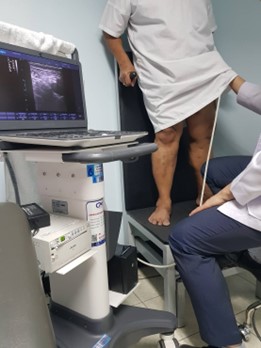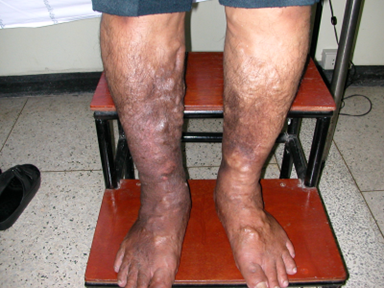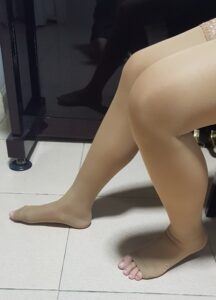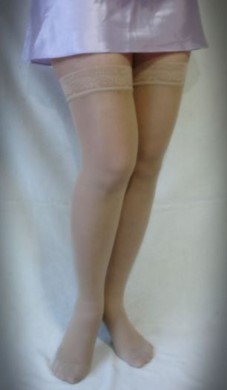Prof. Kittipan Rerkasem
Leg Vein Clinic Thailand
Today, many people with varicose veins (VV) are initially advised by doctors or pharmacies to “try compression stockings” to reduce swelling and leg discomfort. Some feel slightly better, but many complain that “my leg is still swollen” or “the stockings feel tight and uncomfortable,” and eventually stop using them without receiving proper treatment.
As a vascular surgeon specializing in varicose veins, I want to emphasize that compression stockings are not a treatment. They only help “relieve symptoms temporarily”. More importantly, those who experience swelling, heaviness, pain, skin discoloration, or other chronic symptoms should undergo a detailed evaluation—especially “venous duplex ultrasound”, which is essential to identify where reflux or “valve leakage” is occurring.

Image show duplex ultrasound examination for patients with varicose vein
Why Do Varicose Veins Cause Swelling?
Varicose veins result from malfunctioning venous valves, which normally prevent blood from flowing backward down the legs. When these valves weaken or do not close properly, blood leaks downward, increasing venous pressure and causing the vein wall to stretch and bulge—leading to visible varicose veins.
When blood refluxes and pools for long periods, surrounding tissues become swollen, especially in the evening or after standing for long hours. Patients often feel heaviness, tightness, or swelling—early signs of chronic venous insufficiency. If left untreated, it may progress to skin darkening, inflammation, or chronic venous ulcers.

Image show patients with severe chronic venous insufficiency (black skin) due to varicose vein
Compression Stockings: Supportive, Not Curative
Medical compression stockings are certainly helpful—they support venous pressure and reduce swelling. But they cannot repair a leaking valve. Once removed, symptoms typically return.
If your legs remain swollen despite wearing stockings, it is an important sign that a **reflux point** must be identified and treated—not covered up.


Image show patients wear compression stocking
Ultrasound: The Most Important Diagnostic Step
Venous duplex ultrasound is painless, safe, and quick. It identifies exactly where reflux occurs. The most common sites are the **saphenofemoral junction (SFJ)** in the groin and the **saphenopopliteal junction (SPJ)** behind the knee.
Once the reflux point is identified, treatment—such as endovenous laser ablation—can be precisely planned. This is why ultrasound by a trained vascular specialist is far more important than judging varicose veins from appearance alone.
Endovenous Laser Ablation (EVLA): Minimally Invasive and Effective
EVLA is globally accepted as a modern, targeted treatment for venous reflux. It requires only local anesthesia. A laser fiber is inserted through a small needle puncture, then activated to close the leaking vein within minutes.
Patients can walk immediately afterward, do not require hospital stay, and can return to work in 1–2 days. Many describe it as “like a dental procedure”—quick and with minimal discomfort.
Who Should Receive Treatment?
Doctors recommend treatment for patients with medical indications such as:
- Pain, heaviness, or aching legs
- Swelling—especially in the evening
- Skin discoloration or brown pigmentation
- Chronic venous ulcers
- Inflamed veins or bleeding from superficial veins
Those without symptoms may choose conservative management (stockings, exercise, walking, weight control). However, those concerned about appearance or progression can still consult a specialist for preventive treatment options.
Varicose Veins Are Not the Same for Everyone
Some patients have reflux in major veins (saphenous reflux), while others have issues only with small surface veins (reticular or spider veins). Treatment options differ—laser, sclerotherapy, or phlebectomy—and should always be determined by a vascular specialist.
Conclusion
Compression stockings are only a temporary measure—not a cure. If you have swelling, heaviness, pain, skin changes, or non-healing wounds, you should undergo an ultrasound examination to find the true cause.
Once the reflux point is identified, proper treatment such as EVLA can safely and effectively resolve the problem.
You do not need to live with varicose veins forever. Modern treatments are minimally invasive, require no hospitalization, and deliver excellent long-term results.
If your leg remains swollen despite wearing stockings, don’t wait for the condition to worsen—seek evaluation and correct treatment today.
